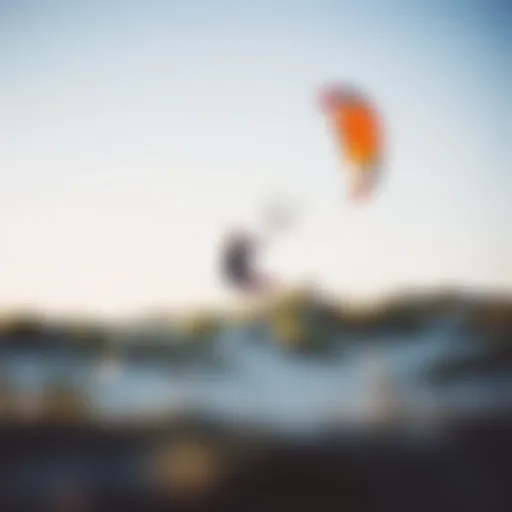The Importance of Dyneema Line in Kiteboarding
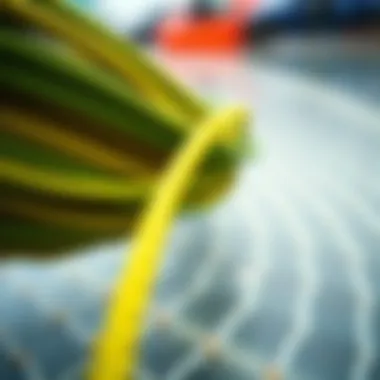
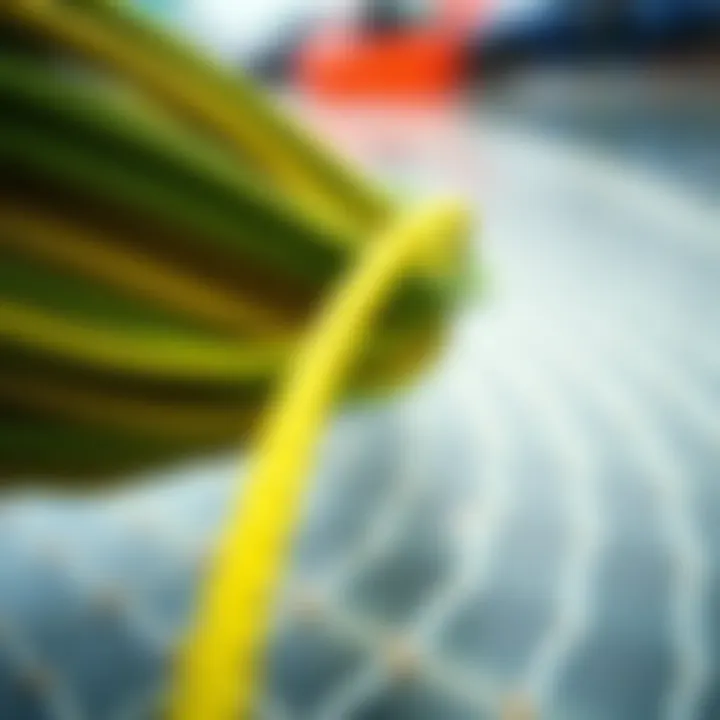
Intro
Kiteboarding is an exhilarating sport that relies heavily on the right gear to enhance performance and safety. Among the many components of kiteboarding gear, the choice of line can make a world of difference. Here, the spotlight is on Dyneema line—a material known for its exceptional strength and lightweight properties. As kiteboarders seek to achieve the perfect balance between control and thrill, Dyneema lines are emerging as a preferred option for enthusiasts and professionals alike. However, understanding why Dyneema is considered essential goes beyond mere surface-level examination; it encompasses aspects such as durability, handling characteristics, and maintenance practices.
In this exploration, we will delve into the nuances of selecting the appropriate gear—beginning with the kite and board. Equipment matters, and the right Dyneema line can turn an average session into an unforgettable experience, transforming how riders interact with the elements. By equipping yourself with knowledge on how to select, maintain, and capitalize on Dyneema lines, you not only invest in your own enjoyment but also contribute to a broader understanding of safety and performance in the kiteboarding community.
Understanding Dyneema Line
Dyneema line has become a cornerstone material in the kiteboarding realm, integral to enhancing both performance and safety. Understanding Dyneema is paramount as it allows kiteboarders to appreciate the nuances of their equipment for a better riding experience. This knowledge translates to not only better kite control but also longevity in gear, which can be key for both casual participants and seasoned professionals.
What is Dyneema?
Dyneema is a high-performance polyethylene fiber, often categorized as super strong and lightweight. Known for its exceptional tensile strength and low stretch properties, Dyneema has carved out a niche in various industries, from marine to outdoor sports. Kiteboarding specifically benefits from Dyneema due to its ability to withstand harsh environmental conditions while providing reliability and safety. This makes Dyneema much more than just an alternative to traditional lines; it’s an advanced solution to the challenges faced on the water.
Unique Properties of Dyneema
High strength-to-weight ratio
One of the standout features of Dyneema is its high strength-to-weight ratio. This property allows kiteboarders to enjoy a lightweight line that doesn’t skimp on durability. Typically, Dyneema is up to 15 times stronger than steel when comparing materials of the same diameter. Such strength minimizes the risk of snapping under pressure, thereby instilling confidence in riders. As kiteboarders engage in complex maneuvers and face high wind velocities, a line that offers both robustness and lightness is absolutely essential.
Low stretch characteristics
Another key attribute is its low stretch characteristics. Fame among kiteboarders comes from the positive impact this has on control. When lines stretch during use, control becomes unpredictable. Low stretch means that the rider can experience immediate and responsive feedback from the kite. This allows for precise movements, essential for performance-oriented riding. As the action unfolds, knowing that your lines won't lengthen unexpectedly is a huge advantage.
Chemical resistance
Moreover, Dyneema boasts impressive chemical resistance. Being exposed to seawater, UV rays, and other elements can deteriorate many materials. In contrast, Dyneema withstands these environmental factors exceptionally well which prolongs the lifespan of the line. Not only does this attribute benefit beginners who might be less diligent about gear maintenance, but it equally ensures that advanced practitioners can focus on their sport rather than fretting over equipment longevity.
Comparing Dyneema with Other Materials
While Dyneema holds a reputation for excellence, it’s important to assess it against other materials used in kiteboarding to fully comprehend its advantages.
Nylon
Nylon is one of the most widespread fibers used in kite lines and leashes. Known for its elasticity, it can absorb shocks well; however, it comes with a notable downside. Nylon tends to stretch significantly under load, which can lead to diminished control over the kite. As a result, while nylon may offer some cushioning, it lacks the precision needed for advanced kiteboarding techniques. This limitation makes it less favorable for those seeking agility and responsiveness in their lines.
Polyester
Polyester stands as another competitor, often prized for its resistance to UV degradation. Also, it holds superior strength when wet, which is beneficial in kiteboarding scenarios. However, polyester tends to have a higher stretch than Dyneema. This bouncing-back effect can be unfavorable during critical maneuvers. Kiteboarders might find themselves needing to correct their control more frequently, translating to a less satisfying experience overall.
"Kiteboarding is not just a sport; it's an expression of freedom, and your choice of line can profoundly affect that experience."
Applications of Dyneema Line in Kiteboarding
Kiteboarding, a sport where precision and durability are key, heavily relies on advanced materials like Dyneema line. This synthetic fiber stands out not only for its strength, but for its versatility across various kiteboarding components. Understanding the applications of Dyneema line is essential for kiteboarders looking to optimize their gear and enhance their overall riding experience.
Usage in Lines and Leashes
Dyneema line is heavily utilized in both the control lines and safety leashes of kiteboarding. Its high-strength capabilities allow for thin profiles, making it ideal for use as a control line that directly connects the kite to the rider. With a strength-to-weight ratio far superior to other materials, Dyneema allows riders to experience a more responsive and dynamic control, crucial when navigating wind conditions.
Moreover, leashes made from Dyneema provide added safety, ensuring that kites can be quickly and efficiently detached from the rider when necessary. The low-stretch characteristics keep the kite stable, providing immediate feedback to the rider, which is particularly vital during critical maneuvers.
Role in Safety Systems
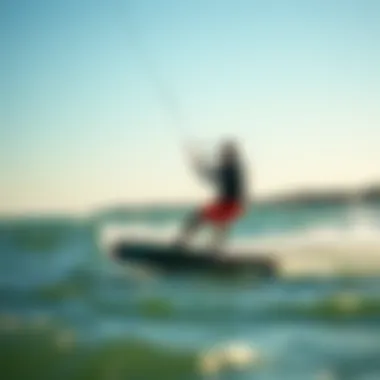
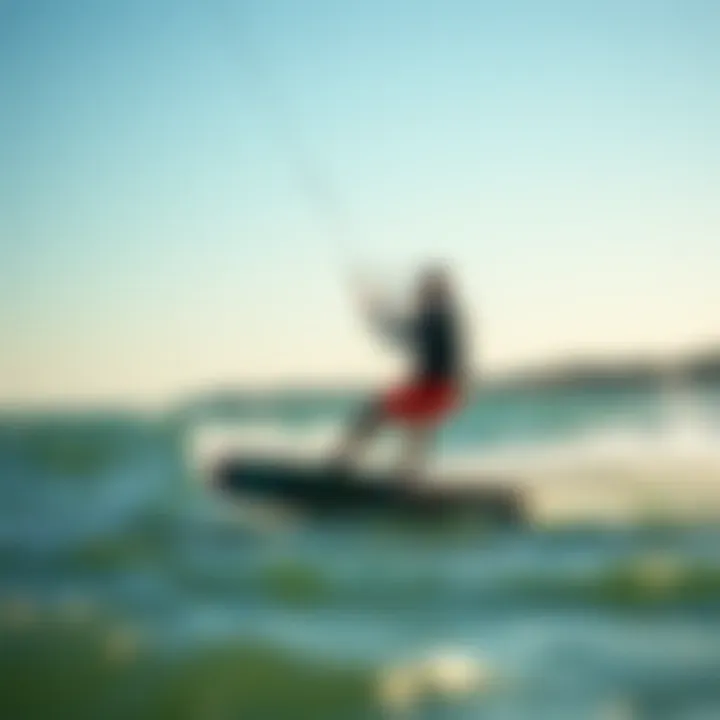
The safety systems in kiteboarding are designed to keep the rider safe in the event of an emergency or malfunction. Dyneema plays a crucial role here due to its inherent resilience and reliability. Many safety release mechanisms benefit from Dyneema’s robust properties, which ensure that they function effectively under pressure.
Furthermore, the line's chemical resistance makes it suitable for various conditions and environments, ensuring that even in wet or salty environments, the material does not degrade easily. For kiteboarders, this means a greater peace of mind knowing that their safety systems will perform effectively, likely saving a rider from potential harm.
Advantage in Competition Settings
In the competitive kiteboarding arena, every detail counts, and Dyneema line can give riders that much-needed edge. Renowned for its lightweight nature, using Dyneema in competition settings can make a noticeable difference in speed and maneuverability. Riders equipped with Dyneema lines often report enhanced performance, particularly in events that require quick turns or jumps.
Additionally, many competitive athletes emphasize the durability of Dyneema line, noting it can withstand the rigors of repeated use without breaking down. This longevity ensures that racers spend less time worrying about gear failure and more time focusing on their game.
"The secret to winning isn't just about skill, but the quality of gear you depend on. Dyneema makes me feel secure to push my limits."
— A competitive kiteboarder
With its myriad applications in kiteboarding, Dyneema line proves to be an essential resource. Its effectiveness in lines, leashes, safety systems, and competitive environments further solidifies its position as a go-to material for enthusiasts and professionals alike.
Key Factors When Choosing Dyneema Line
Selecting the right Dyneema line involves more than just picking a color or brand. It requires an understanding of specific factors that can significantly affect your kiteboarding experience. Each element plays a crucial role in ensuring your line meets the practical demands of the sport while also considering your preferences for durability and performance.
Line Width and Length Considerations
When it comes to line width and length, there are various aspects to ponder. The width of your Dyneema line impacts its overall strength and handling. Thicker lines tend to bear more strain, though they may also add to the drag, affecting your speed. Conversely, thinner lines are lighter and can enhance your performance during high-speed maneuvers. It’s a bit of a balancing act, really – you want to ensure that the line can hold up under pressure without feeling cumbersome.
Length is another critical factor. Longer lines might provide better kite performance, offering more pull and lift. However, they may also complicate control, especially for those still honing their kiteboarding skills. Shorter lines offer more direct response, which is crucial for precision riding or tricks. Striking the right chord with both width and length is essential.
Weight and Strength Requirements
Understanding the relationship between weight and strength in Dyneema line is vital to elevate your kiteboarding experience. The lightweight nature of Dyneema is one of its standout features, allowing for ease of handling while still maintaining high durability. But keep in mind that “weight” isn’t just about how heavy the line feels in your hands – it impacts how your kite performs during various weather conditions. In gusty winds, a lighter line may respond too quickly to changes, while a heavier line might not react swiftly enough.
On the strength side of things, you want to ensure that the line you choose meets or exceeds the demands posed by your equipment. Dyneema lines come with various tensile strengths, so knowing your kite’s requirements will guide your selection. Ensuring that your line is robust enough to handle your preferred style and the associated stresses will prevent wear and tear in the long run.
Environmental Impact and Sustainability
While the thrill of kiteboarding often takes center stage, the environmental impact of your equipment deserves a moment of consideration. Dyneema, which is made from ultra-high molecular weight polyethylene, comes with its own ecological footprint. While this material is known for its durability, it’s essential to look into the manufacturer's practices concerning sustainability. Many companies are now focusing on reducing waste and enhancing recyclability. Some even offer programs to recycle used Dyneema lines, thus mitigating the impact on our oceans and local environments.
Being an informed kiteboarder means you can make choices that echo your concern for the planet. Opt for brands that prioritize environmentally-friendly processes. It’s a win-win situation, allowing you to enjoy your sport while contributing to its sustainability.
In summary, when you’re on the lookout for Dyneema line, keep an eye on width, length, weight, strength, and the environmental implications of your choices. This thoughtful approach will ultimately result in a more rewarding kiteboarding experience.
Maintaining Dyneema Line
Caring for your Dyneema line is not just a good practice; it's an essential part of responsible kiteboarding. The potential ease of maintaining these lines does not negate their need for regular care. Since Dyneema is praised for its durability and strength, neglecting maintenance can lead to unexpected failures in performance. This can be especially dangerous when you're out on the water, where circumstances can shift rapidly. Here’s a closer look at the best ways to maintain your Dyneema line effectively.
Cleaning Techniques
Keeping your Dyneema line clean is paramount. Salt, sand, and dirt can accumulate quickly, and over time, that gunk can degrade the fibers. It’s as simple as giving your lines a rinse after each outing.
You can follow these steps:
- Rinse with Fresh Water: After your session, dunk the lines in fresh water. Give 'em a good shake to remove any salt or sand.
- Gentle Scrubbing: For stubborn dirt, use a soft brush or cloth. Avoid anything too abrasive; you wouldn’t want to scuff up those fibers.
- Air Dry: Let the lines dry hanging up, away from direct sunlight. This keeps them in tip-top shape while avoiding potential UV damage.
"A clean line is a happy line!"
Taking just a few minutes to clean the Dyneema line can significantly extend its lifespan and ensure optimal performance.
Storage Recommendations


When it comes to storage, treating your Dyneema line kindly can prevent unnecessary wear and tear. Here are certainly some solid storage practices to consider:
- Avoid Tight Wrapping: When coiling your lines, don’t wrap them too tightly. Create loose loops and secure them with a gentle tie instead.
- Dry Before Storage: Make sure your lines are completely dry before stowing them away. Moisture can lead to mildew, which is the last thing you want lurking in your gear.
- Keep Out of Sunlight: Store lines in a cool, dark place. Prolonged exposure to ultraviolet rays can weaken Dyneema, despite its remarkable resistance.
Identifying Wear and Tear
Recognizing when Dyneema lines are wearing out is critical to ensuring your safety on the water. Familiarize yourself with what signs to look for:
- Surface Damage: Regularly check along the length of the line for fraying or discoloration. These can indicate weakness in the fibers.
- Feel for Texture Changes: Run your fingers along the line. If it feels rough or has irregularities, it might be time for a replacement.
- Look for Stretching: If your line seems to have stretched more than usual, that can be a signal it’s nearing the end of its lifespan.
By routinely checking these factors and staying on top of maintenance, you can enjoy many thrilling sessions of kiteboarding without worry. In the ever-changing winds and waves, your Dyneema lines should be the least of your concerns.
Dyneema Line for Sale: Market Overview
The selection of Dyneema line has become a pivotal subject within the kiteboarding industry. It goes beyond just choosing a product; it entails understanding the dynamics of the market. This makes it crucial for kiteboarding enthusiasts to grasp where and how to acquire the right Dyneema line. The purpose of this section is threefold: to spotlight reputable brands, offer insights into pricing, and direct readers towards optimal purchasing channels. Every bit of information will assist in navigating the marketplace effectively, ensuring that kitesurfers invest in quality that meets their needs.
Top Brands to Consider
When diving into the market of Dyneema lines, knowing which brands stand tall among the rest is essential. Here are a few that have earned their stripes in quality and performance:
- MBS – Known for their high-strength Dyneema lines, suitable for the most intense kiteboarding conditions.
- Cabrinha – Offers a balance between performance and reliability, frequently praised for their product’s longevity.
- North Kiteboarding – Their Dyneema lines are often regarded for innovative designs and user-friendly features.
- Slingshot – With a solid reputation, they cater to both recreational and competitive kiteboarders.
These brands consistently receive positive feedback from users, making them trustworthy choices. However, kiteboarders ought to validate that they select the specific line suited to their personal style and needs.
Pricing Insights and Variations
When it comes to Dyneema lines, prices can swing significantly based on several factors including brand, length, and specialized features. Here’s what to keep in mind:
- Standard Pricing Range: Generally, you can expect to pay between $20 to $100 per line.
- Factors Influencing Price:
- Length: A longer line typically costs more due to the increased material used.
- Quality: Higher-end products often showcase better durability and performance, leading to increased prices.
- Features: Specialty traits like color-coded markings or extra reinforcement can also affect cost.
Potential buyers should keep an eye out for seasonal discounts or bundles that some brands offer, as these can significantly lower overall expenses.
Where to Buy: Online and Retail Options
Finding the right place to purchase Dyneema line demands some thought. Online options provide extensive variety, while local shops offer tangible inspection. Here’s a breakdown:
- Online Options:
- Retail Options:
- Amazon: A wide range of brands available, plus customer reviews to guide selections.
- eBay: Great for unique finds, though one should ensure seller credibility.
- Dedicated Kiteboarding Sites: Websites like Kiteboarding.com or TheKiteBoarder.com regularly stock various Dyneema lines and often feature expert reviews.
- Local Pro Shops: Often provide personalized guidance; allow customers to physically examine the product.
- Sporting Goods Stores: While they may not have the broadest selection, they can carry reputable brands.
In essence, whether online or in-store, the key is to source products that deliver performance and durability.
"Choosing the right Dyneema line can transform your kiteboarding experience, enhancing not just safety but overall enjoyment."
Those considering a purchase should weigh their options carefully, making it a priority to choose the best fit for their kiteboarding experiences.
Safety and Regulations
Understanding the nuances surrounding safety and regulations in kiteboarding is not a luxury—it's a necessity. When you venture into the exhilarating world of kiteboarding, recognizing the standards that govern equipment and practices ensures that your experience is not only thrilling but also safe. In the realm of kiteboarding, Dyneema lines have revolutionized gear reliability, yet they come with their own set of guidelines and best practices to keep in mind.
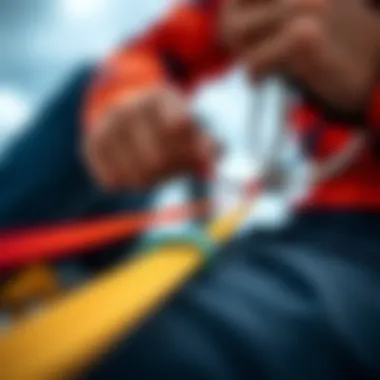
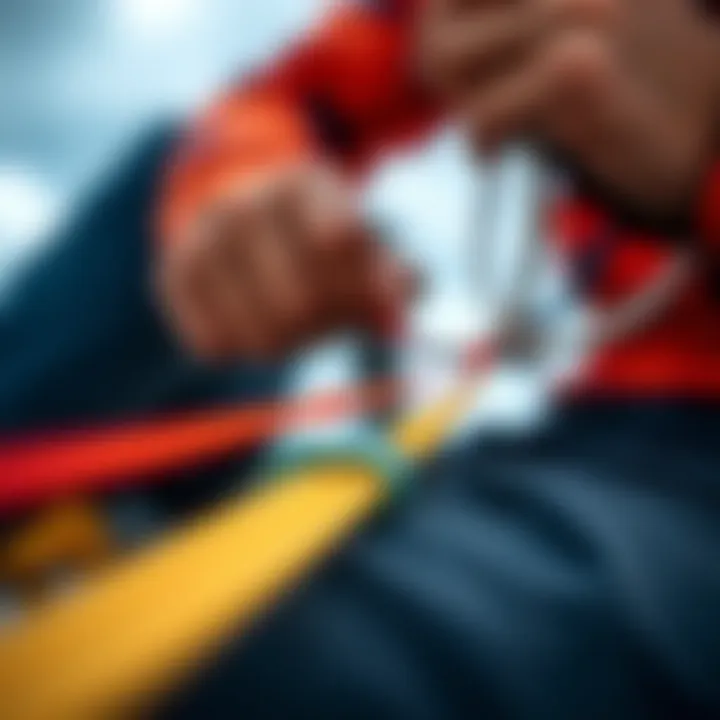
Industry Standards and Guidelines
Industry standards for kiteboarding gear, including Dyneema lines, primarily stem from organizations like the International Kiteboarding Organization (IKO) and the American Kiteboarding Association (AKA). These bodies establish clear-cut specifications that dictate the strength, durability, and performance metrics of kiteboarding lines. Some key elements include:
- Breaking Strength: Dyneema lines are tested to ensure they can withstand significant loads without failure. Each line should meet or exceed the minimum breaking strength recommended by industry standards.
- Certification Standards: Check for certifications. Equipment that meets CE or ISO standards typically signifies a higher degree of scrutiny in its manufacturing.
- Material Specifications: Specifications detail characteristics such as UV resistance and abrasion levels. These are critical for ensuring longevity under harsh conditions.
"Following industry standards isn't just about compliance; it's about protecting yourself and fellow kiteboarders on the water."
An awareness of these standards boosts confidence among users, enabling safer and more reliable experiences on the water.
Best Practices for Usage
Incorporating best practices into your kiteboarding routine with Dyneema lines underscores your commitment to safety and performance. Here are important recommendations:
- Regular Inspections: Before heading out, check your lines for fraying, knots, or any signs of wear. It's better to spot issues on land rather than during a run.
- Proper Storage: After use, store your Dyneema lines in a cool, dry place away from direct sunlight. Excessive exposure can degrade the material over time.
- Avoid Abrasive Surfaces: Keep your lines clear of sharp edges or surfaces while rigging. Even Dyneema's strength can be compromised by excessive friction.
- Weight Considerations: Be mindful of how line weight affects performance. Different setups may require varying lengths and widths to match your board and conditions.
- Stay Informed: Engage with community forums like those on Reddit (https://www.reddit.com/r/Kiteboarding) or manufacturer newsletters to stay updated on safety alerts relevant to your equipment.
By adhering to these practices, you not only ensure your safety but also contribute to a responsible kiteboarding culture that prioritizes every participant's wellbeing.
Future Trends in Dyneema Technology
The evolution of Dyneema technology is a pathway to understanding how kiteboarding can advance. Various innovations in this field certainly hold the power to not only enhance performance but also ensure sustainability—both crucial for modern kiteboarders. As the kiteboarding community seeks better options, it becomes evident that staying informed on these trends is a game changer, allowing enthusiasts to make smarter choices.
Dyneema, known for its exceptional strength and low stretch, is not a static fabric; it evolves with advancements in fiber technology. The intersection of performance and eco-conscious choices makes it a topic worth its weight in gold. As kiteboarding continues to grow, the shifts in Dyneema technology will likely shape the future landscape of the sport.
Innovations in Fiber Development
The race for lighter yet sturdier materials is ceaseless, and Dyneema remains at the forefront. Recent innovations focus on developing new fiber structures that increase the durability of line while maintaining its lightweight property. For instance, some companies are experimenting with varying filament arrangements, resulting in Dyneema lines that boast better abrasion resistance and improved flexibility. This means consumers can expect lines that withstand the wear and tear of both salty oceans and rugged winds, extending the life of their equipment.
- Hybrid Fiber Compositions: Emerging trends show interest in blended fibers that may enhance Dyneema's performance. Combining Dyneema with other materials could bring about a new era of flexibility, making it easier for kiteboarders to engage with different kite systems.
- Multi-functional Lines: As technology develops, expect to see Dyneema lines equipped with additional features, such as integrated sensors for real-time performance metrics. This addition could help riders adjust techniques on-the-fly, enhancing their experience and safety.
"Continuous innovation in Dyneema technology signifies how the kiteboarding industry is evolving—brands are not just responding to demands but setting the stage for what’s next."
Potential Environmental Improvements
Sustainability is increasingly becoming a priority in many sports, and kiteboarding is no exception. Dyneema, traditionally known for its incredible strength, is now also being evaluated for its environmental impact. As kiteboarders become more aware of their carbon footprint, improvements in the production process of Dyneema are becoming crucial.
One significant area to watch is the potential use of bio-based materials to create Dyneema lines. Research is ongoing to find sustainable alternatives to the typical petroleum-based polymers, paving the way for greener options without sacrificing performance.
- Reduced Energy Consumption: Next-generation Dyneema production methods may focus on reducing the energy consumed during manufacturing. This not only cuts costs but also aligns with the broader shift towards energy efficiency.
- Recycling Initiatives: As awareness grows, more manufacturers are exploring recycling initiatives for used Dyneema products. With proper programs in place, kiteboarders could return their worn-out lines for remanufacturing, contributing to a more circular economy.
Understanding these future trends not only showcases the relentless pursuit of advancement within the kiteboarding industry but also highlights how these innovations can positively impact both the sport and its environment. These developments are paving the way for kiteboarding to become more efficient, eco-friendly, and sustainable—asserting the community’s commitment to both performance and planet.
End and Takeaways
In wrapping up our discussion on Dyneema line and its pivotal role in kiteboarding, it’s clear that this material is more than just a trend; it’s a game changer for those pursuing the exhilarating sport of kiteboarding. Understanding the attributes of Dyneema and how it stands up against other materials cannot be overstated. The strength, lightweight nature, and minimal stretch of Dyneema enable riders to experience enhanced performance, whether they’re cruising across waves or tackling jumps.
Summarizing Key Points
The article has explored several key aspects that every kiteboarding enthusiast should consider:
- What Dyneema Is: This synthetic fiber is made from ultra-high-molecular-weight polyethylene, providing unmatched durability.
- Unique Properties: It boasts an astonishing strength-to-weight ratio and remains resistant to chemicals, making it ideal for various kiteboarding conditions.
- Practical Applications: From lines to leashes, Dyneema proves to be advantageous not only for recreational use but also in competitive contexts.
- Safety and Regulations: Following industry standards is crucial for ensuring a safe experience.
- Future Trends: Ongoing innovations promise even more improvements in fiber development and sustainability, indicating a bright path ahead for this material in the kiteboarding world.
Each point reinforces the necessity for kiteboarders to engage with their equipment in an informed manner, ensuring the best possible outcomes on the water.
The Importance of Informed Selection
Informed selection of Dyneema line isn't simply beneficial; it's paramount. Kiteboarding is a thrilling yet risky activity, demanding utmost reliability from equipment. Using Dyneema line properly means considering factors like line width, strength, and the specific conditions in which one intends to ride.
Investing in quality Dyneema components not only upgrades performance but also significantly enhances safety. A well-informed rider is one who can maximize their enjoyment while minimizing risk. Furthermore, as advancements in Dyneema technology continue, kiteboarders must stay updated on new developments that could yield better performance and environmental benefits.
Emphasizing knowledge and awareness, kiteboarders can make choices that foster both their journey in the sport and the overall health of the environment. Investing in Dyneema line means investing in future kiteboarding adventures, equipped with a material that stands the test of time, ruggedness, and increasingly demanding kiteboarding scenarios.



